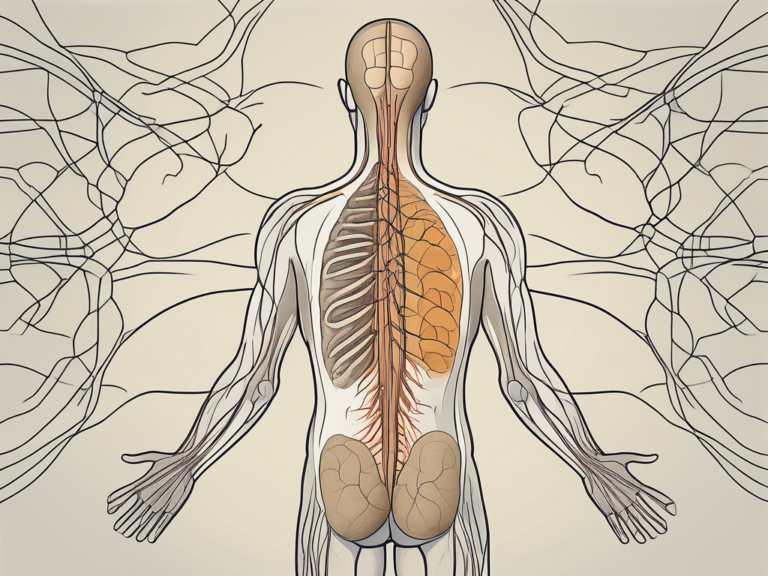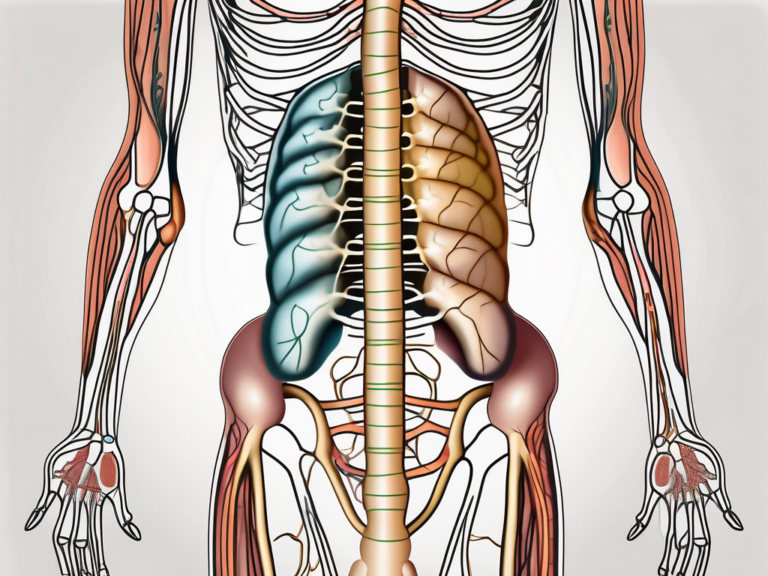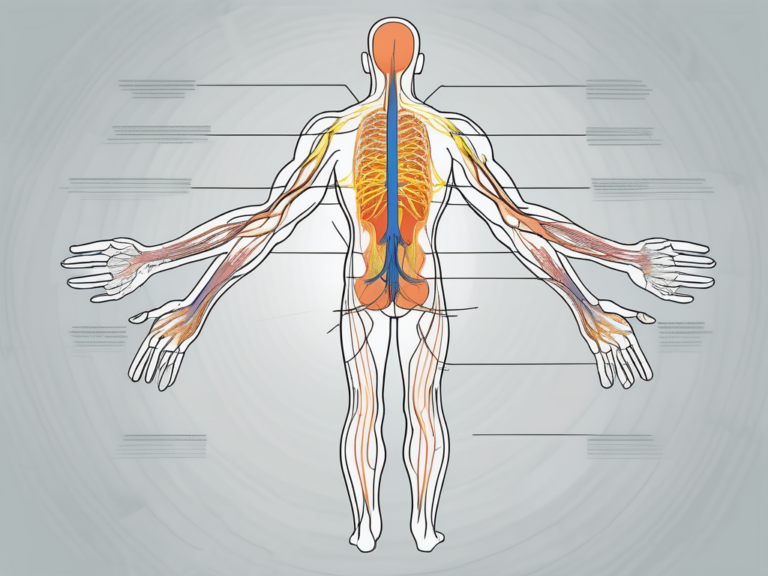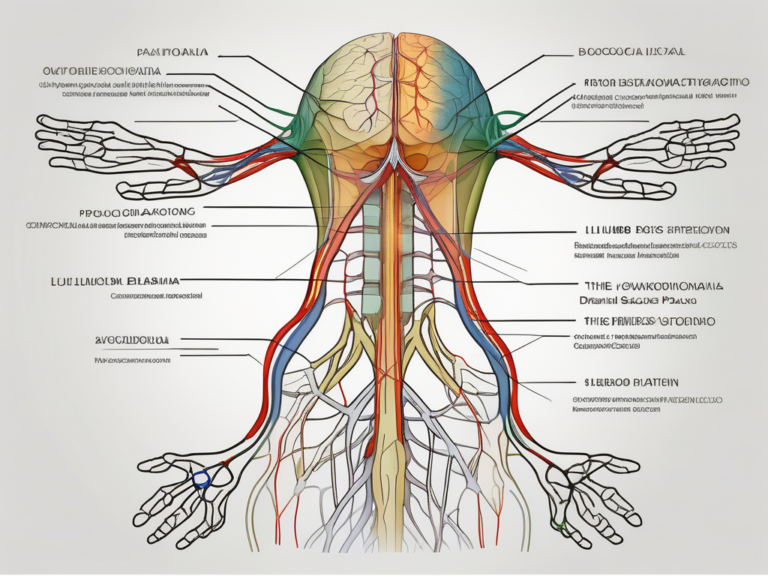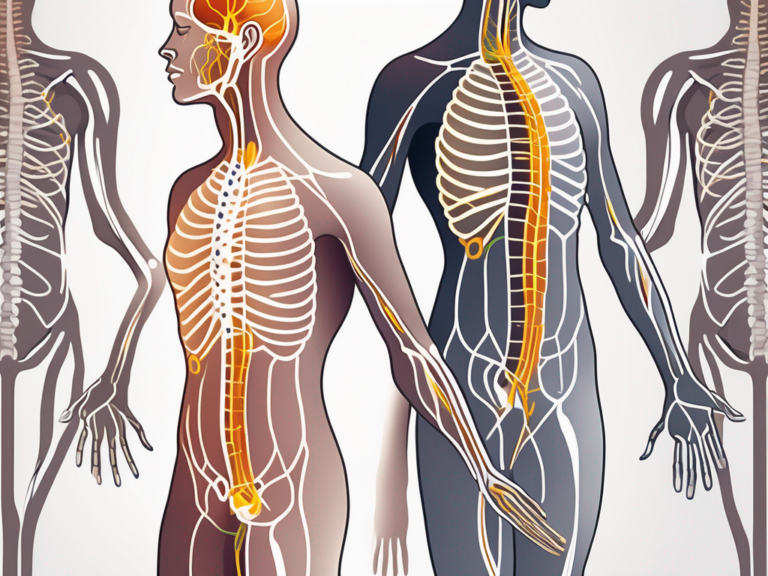How Many Nerve Roots Constitute the Sacral Plexus?
The sacral plexus is a complex network of nerves that plays a crucial role in the functioning of the lower body. Understanding the composition and function of the sacral plexus can provide valuable insights into various disorders that may affect it. In this article, we will explore the anatomy of the sacral plexus, the role of nerve roots in its formation, common disorders associated with it, and available treatment options.
Understanding the Sacral Plexus
The sacral plexus is formed by a collection of nerve roots that emerge from the lower spinal cord. It is located in the pelvic region, supplying motor and sensory nerves to the lower limbs, pelvis, and perineum. The sacral plexus is responsible for controlling movements, sensation, and reflexes in these regions.
The sacral plexus is a complex network of nerves that plays a crucial role in the functioning of the lower body. Let’s dive deeper into the anatomy and function of this fascinating structure.
Anatomy of the Sacral Plexus
The sacral plexus is primarily formed by the fusion of nerves originating from the fourth and fifth lumbar (L4-L5) and first four sacral (S1-S4) spinal nerves. These nerve roots join together to form a network of nerves, which then branch out to innervate different muscles and organs in the lower body.
Within the sacral plexus, there are several major nerves that arise from its intricate network. The sciatic nerve, the largest nerve in the body, originates from the sacral plexus and extends down the back of the thigh, providing motor and sensory innervation to the lower leg and foot. Other important nerves that branch off from the sacral plexus include the pudendal nerve, which supplies the pelvic floor muscles and the perineum, and the superior gluteal nerve, which innervates the gluteus medius and minimus muscles.
The sacral plexus is a dynamic structure, constantly sending and receiving signals to and from the brain. This intricate network of nerves allows for the coordination of complex movements and the transmission of sensory information.
Function of the Sacral Plexus
The sacral plexus is involved in various functions, including motor control and sensory perception. It provides innervation to the lower limbs, allowing for voluntary movements such as walking, running, and balance. The muscles of the legs, including the quadriceps, hamstrings, and calf muscles, receive signals from the sacral plexus, enabling us to perform a wide range of movements with precision and control.
In addition to motor control, the sacral plexus carries sensory information from the lower body to the brain, allowing us to perceive touch, temperature, and pain sensations. When you touch a hot surface with your foot or stub your toe, it is the sacral plexus that relays this information to your brain, triggering a reflexive response to protect yourself from further harm.
Furthermore, the sacral plexus plays a crucial role in the functioning of the pelvic organs. It provides innervation to the bladder, allowing for the control of urination, and to the reproductive organs, enabling sexual function and fertility.
Overall, the sacral plexus is a vital component of the nervous system, facilitating the control of movement, sensation, and reflexes in the lower body. Its intricate anatomy and multifaceted functions make it an essential structure for our everyday activities and well-being.
The Nerve Roots of the Sacral Plexus
The sacral plexus is a complex network of nerves that plays a crucial role in the functioning of the lower body. It is formed by the convergence of several nerve roots, each with its own unique identification and role.
Understanding the identification and role of each nerve root is essential in comprehending the intricate functioning of the sacral plexus. Let’s delve deeper into the fascinating world of these nerve roots.
Identifying the Nerve Roots
The sacral plexus is primarily formed by the spinal nerves L4-S4. These nerve roots arise from different levels of the spinal cord and contribute to the formation of the upper and lower parts of the sacral plexus.
The nerve roots originating from the fourth and fifth lumbar vertebrae, namely L4 and L5, contribute to the formation of the upper part of the sacral plexus. On the other hand, the nerve roots arising from the sacral vertebrae, S1-S4, contribute to the lower part of the plexus.
It is fascinating to think about how these nerve roots come together to form a complex network, allowing for the transmission of signals and information throughout the lower body.
Role of Each Nerve Root
Each nerve root that contributes to the sacral plexus has specific functions, making them vital components of the intricate neural system.
The lumbar nerve roots, specifically L4 and L5, play a crucial role in providing motor and sensory innervation to various parts of the lower body. These nerve roots are responsible for innervating the anterior thigh muscles, allowing for movements such as walking, running, and jumping. Additionally, they provide sensory information from the knee and ankle joints, enabling us to perceive touch, pressure, and pain in these areas.
On the other hand, the sacral nerve roots, S1-S4, have their own important role in the functioning of the lower body. These nerve roots innervate the muscles of the buttocks, posterior thigh, and the entire leg and foot. They are responsible for controlling movements such as hip extension, knee flexion, and ankle plantar flexion. Without the innervation provided by these nerve roots, our ability to move and perform various activities would be severely compromised.
It is truly remarkable to think about how these nerve roots work together to ensure the smooth functioning of our lower body. The intricate interplay between these nerve roots allows us to walk, run, dance, and engage in countless other activities that we often take for granted.
Next time you take a step or feel the sensation of the ground beneath your feet, remember the incredible complexity of the sacral plexus and the vital role played by its nerve roots.
The Connection Between Nerve Roots and the Sacral Plexus
The nerve roots of the sacral plexus play a vital role in the formation and functioning of the plexus as a whole. Understanding how these nerve roots come together to form the sacral plexus can provide valuable insights into its complexity and importance.
The sacral plexus is a fascinating network of nerves that originates from the lumbar and sacral regions. It is through the intricate merging of these nerve roots that the sacral plexus takes shape. Imagine a beautiful tapestry being woven together, with each thread representing a nerve root, intricately connecting to form a complex web of nerves.
Within the sacral plexus, these nerve roots intertwine and create a highly efficient system for transmitting signals between the spinal cord and the lower body. This intricate network allows for seamless communication between the central nervous system and the various muscles, organs, and tissues in the lower region of the body.
How Nerve Roots Form the Sacral Plexus
Let’s delve deeper into the process of how the nerve roots from the lumbar and sacral regions come together to form the sacral plexus. It all begins in the spinal cord, where the nerve roots emerge and branch out. As they extend downwards, they gradually merge and intertwine, forming a complex network.
Within this network, the nerve roots give rise to various branches that innervate different areas of the lower body. These branches extend to the muscles, skin, and organs, allowing for precise control and sensation in this region. It is truly remarkable how these nerve roots, originating from different regions of the spine, seamlessly integrate to form a cohesive and functional unit.
The Importance of Nerve Roots in the Sacral Plexus
The nerve roots are not just mere components of the sacral plexus; they are essential for its proper functioning. Without these nerve roots, the sacral plexus would not exist, and the communication between the spinal cord and the lower body would be severely compromised.
Disruption or damage to these nerve roots can have significant consequences. Various disorders and impairments in motor and sensory functions can arise when the nerve roots are compromised. Conditions such as sciatica, which is characterized by pain, weakness, and numbness in the lower back and legs, can occur when the nerve roots of the sacral plexus are compressed or injured.
Given the vital role of the nerve roots in the sacral plexus, it is crucial to protect and maintain their health. This can be achieved through proper posture, regular exercise, and avoiding activities that put excessive strain on the lower back. By taking care of our nerve roots, we can ensure the smooth functioning of the sacral plexus and promote overall well-being.
Disorders Related to the Sacral Plexus
Despite its robust nature, the sacral plexus can be subject to various disorders that may affect its normal functioning. Recognizing and understanding these disorders is crucial in seeking timely medical intervention and management.
The sacral plexus is a complex network of nerves located in the pelvis, responsible for innervating the lower limbs and pelvic organs. It is formed by the merging of the lumbosacral nerves, originating from the lumbar region of the spine. This intricate network ensures the proper functioning of the lower body, allowing for voluntary movements, sensory perception, and control of bladder and bowel functions.
Common Disorders of the Sacral Plexus
Some common disorders associated with the sacral plexus include sacral nerve root compression, sacral plexopathy, and lumbosacral radiculopathy. These conditions can cause symptoms such as pain, weakness, altered sensation, and difficulty with motor control.
Sacral nerve root compression occurs when the nerves within the sacral plexus are compressed or pinched, leading to pain and dysfunction. This compression can be caused by various factors, including herniated discs, spinal stenosis, or trauma to the lower back. The resulting symptoms may radiate down the legs, causing discomfort and limiting mobility.
Sacral plexopathy refers to damage or dysfunction of the sacral plexus itself. This can occur due to trauma, infection, inflammation, or tumors in the pelvic region. The symptoms of sacral plexopathy can range from mild to severe, depending on the extent of nerve damage. Patients may experience weakness or paralysis in the lower limbs, loss of sensation, and difficulties with bladder and bowel control.
Lumbosacral radiculopathy, also known as sciatica, occurs when the spinal nerves that make up the sacral plexus are compressed or irritated as they exit the spinal column. This compression can be caused by conditions such as herniated discs, spinal degeneration, or spinal tumors. The hallmark symptom of lumbosacral radiculopathy is radiating pain that travels from the lower back down the buttocks and legs.
Symptoms and Diagnosis of Sacral Plexus Disorders
The symptoms of sacral plexus disorders can vary depending on the specific condition and the extent of nerve damage. Common symptoms include radiating pain, numbness or tingling, muscle weakness, and difficulty with balance and coordination.
Diagnosis often involves a thorough physical examination, imaging tests, and nerve conduction studies to assess the extent of nerve damage. During the physical examination, a healthcare provider may evaluate the patient’s reflexes, muscle strength, and sensory perception. Imaging tests such as magnetic resonance imaging (MRI) or computed tomography (CT) scans can provide detailed images of the sacral plexus and surrounding structures, helping to identify any abnormalities or compression. Nerve conduction studies involve measuring the electrical activity of the nerves, which can help determine the location and severity of nerve damage.
Early diagnosis and intervention are crucial in managing sacral plexus disorders. Treatment options may include physical therapy, medications to manage pain and inflammation, and in severe cases, surgical intervention to relieve nerve compression. Rehabilitation and ongoing care are often necessary to optimize function and improve quality of life for individuals with sacral plexus disorders.
Treatment and Management of Sacral Plexus Disorders
Effective treatment and management of sacral plexus disorders require a comprehensive approach that addresses the underlying cause and alleviates the associated symptoms. While each case may vary, treatment options generally include both non-surgical and surgical interventions.
Sacral plexus disorders can be debilitating, causing pain and affecting mobility. However, with the right treatment plan, individuals can experience significant improvement in their condition and regain their quality of life.
Non-Surgical Treatments for Sacral Plexus Disorders
Non-surgical treatments for sacral plexus disorders often focus on pain management and physical therapy to improve muscle strength and function. Pain medications, such as nonsteroidal anti-inflammatory drugs (NSAIDs) or opioids, may be prescribed to help alleviate the discomfort associated with the condition.
In addition to medication, physical therapy plays a crucial role in the non-surgical management of sacral plexus disorders. A skilled physical therapist can design a personalized exercise program that targets the affected muscles and nerves, helping to improve their strength and function. These exercises may include stretching, strengthening, and balance exercises, all tailored to the individual’s specific needs.
Furthermore, assistive devices, such as braces or orthotics, may be recommended to provide additional support and stability to the affected area. These devices can help reduce pain and improve mobility, allowing individuals to engage in daily activities with greater ease.
It is important to note that non-surgical treatments may take time to yield noticeable results. Patience and consistency are key when undergoing these interventions, as the body needs time to heal and adapt to the treatment plan. Regular follow-up appointments with healthcare professionals are essential to monitor progress and make any necessary adjustments to the treatment plan.
Surgical Options for Sacral Plexus Disorders
In more severe cases, surgical intervention may be necessary to alleviate compression or repair damaged nerves in the sacral plexus. Surgical options may include nerve decompression, nerve grafting, or nerve transfer procedures.
Nerve decompression involves relieving pressure on the affected nerves by removing any surrounding structures that may be compressing them. This procedure aims to restore normal nerve function and alleviate pain and other symptoms.
Nerve grafting is another surgical technique used to repair damaged nerves. During this procedure, a healthy nerve is taken from another part of the body and transplanted to the damaged area. This allows for the regeneration of nerve fibers and the restoration of proper nerve function.
In some cases, nerve transfer procedures may be performed. This involves redirecting a healthy nerve from a less critical area to the damaged area, allowing for improved nerve signaling and function.
The decision to undergo surgery should be made in consultation with a qualified healthcare professional. They will evaluate the severity of the condition, the potential benefits and risks of surgery, and the individual’s overall health status before recommending the most appropriate surgical option.
Recovery from surgical interventions for sacral plexus disorders can vary depending on the complexity of the procedure and the individual’s overall health. Rehabilitation and physical therapy are typically recommended post-surgery to aid in the recovery process and optimize outcomes.
In conclusion, the treatment and management of sacral plexus disorders require a multidisciplinary approach that combines non-surgical interventions, such as pain management and physical therapy, with surgical options when necessary. With proper care and guidance from healthcare professionals, individuals with sacral plexus disorders can experience significant improvement in their symptoms and regain their quality of life.
Conclusion
In conclusion, the sacral plexus consists of multiple nerve roots originating from the lumbar and sacral regions. Understanding the composition and functioning of the sacral plexus is important in recognizing and managing various disorders that may affect it. If you are experiencing any symptoms or concerns related to the sacral plexus, it is essential to consult with a healthcare professional who can provide accurate diagnosis and appropriate treatment options.

